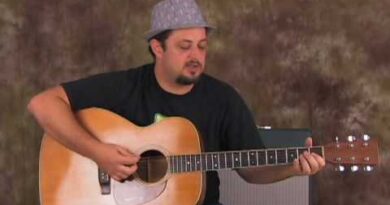What Are The Guitar Modes Guitar Lesson
Modes! These are the most daunting things a guitarist can learn, but they really are a lot easier than you may think. This guitar lesson should hopefully sort you out
Check out a 40min lesson on How to use the modes on my website:
Mike’s Website: http://www.mikebradleymusic.com
Subscribe: http://bit.ly/15Lo3tA
Facebook: https://facebook.com/officialmikebradley
Instagram: https://www.instagram.com/mikebradleyofficial
Twitter: https://twitter.com/mikejbradley
Get my EP on CD by emailing: Mikebradguitar@aol.com
Get it digitally from:-
iTunes: http://apple.co/1Nceqns
Amazon: http://amzn.to/1Cu0qQ8
Google Play: http://bit.ly/1GzcZdH
#Guitar #Modes #Guitar #Lesson
Originally posted by UCB9O8wal-ctnZCDBXDb_rrQ at https://www.youtube.com/watch?v=vo67uw–Ch0




how do i know what the chord progressions are for each mode? thanks Mike!
Absolutely brilliant, Mike! I've been studying modes for several years, in college courses, some books and lots of different internet videos. Yours is truly the very best lesson I've seen yet. I've thought for quite a while, "Why doesn't someone just present a really good, FUNDAMENTAL lesson on modes so that people can see how simple it actually is and PLAY each mode with its corresponding chord?" Well, you've done it, and beautifully [it helps to be a very good guitarist…… ????!]. Well done. I hope many more guitarists discover your excellent — and fun! — lessons. ????
One of the best explanations of this topic on YouTube! Thank you for making this subject crystal clear to me. Also , your examples really illustrated the difference in the general moods of the modes.
Bravo to you mate from the US .????????????????????????????????????????
''It's Greek words, blame the Greeks'' meanwhile me, a Greek: Yeah, I feel you mate.
Which Startocaster model is this?
14:29 im confused you are the expert on this but i think you made a mistake isnt that the formula for building the Dorian. i think the formula for mixolydian is just b7th. if im wrong please correct me.
also thanks for the amazing video
Dude! Thank you! I understand modes now ????????
Sweet Jesus, after months of trying to understand this is the most clear video I have watched.
I wanted to thumbs up over and over again. Awesome, clear, helpful.
I've been looking all day to find someone that can explain the modes clearly. You are the best of the best.
Feel like I've been wandering around the stands in a large dark stadium with a torch and the lights are slowly coming on. The modes are now being to make sense ~ at flipping long last! Saved the link, going to watch this again, then head over to your website. Thanks a TON!
Bro thank you????????
Give me A fridge Ian. You def are the best tutor thanks, if I make it back to Blighty I'll fork out for a few lessons – but there's no way I'm visiting Guilford, no one ever goes there, no one ever leaves there. Brighton where I bought the old Fender Acoustic in 1993.
D dorian – Call me by Blondie; A Phrygian – Sunday Girl….they were better than we give credit for (my first LP!). I'm just starting out on theory and the results are amazing, the confusion is deadly, infinite, however.
Can you do this with other scales?
Excellent explanation. Thanks very much.
Even my cat is playing the Locrian Mode after watching this video !! Well done Mike !!!!!!
Really enjoy your videos. Watched some others on modes. Your explanation was the best and easiest to follow.
Mate!!!!!!!!!!!!!!!!!!!!!!!!!!!!!!!!!!!! you're gold! Thanks so much:)
watched a few utube videos on modes and after watching this one finally got some sense.
Probably one of the best videos I've seen on modes. Most guitarist really have an ass-backwards way of approaching modes.If you don't understand triads and your diatonic chords, you will never really understand modes. Modes are not scales, they're the harmonic backround. If you play a "Flydian scale" over a D-7 chords, you are in D Dorian, not F lydian. Try playing a B min pentatonic of a CMaj7 chord… What mode are you in then? Wanna play in Locrian.. Loop the following notes as 8th notes (F# C B D C A B G) and solo in Gmaj then Emin, then A dorian Cldian.. Solo in any of those and you're still in F# Locrian. The best thingis to learn some modal songs ei "So What" by Miles Davis.. You can solo in and mode based of of CMaj and you're still in D dorian.
How do you which chords it would be? Would be the chords in the original scale like c major or would it be chords in the mode? Sorry if this sounds stupid. Thanks!
What I have struggled to understand is how they relate to keys. If ANYONE can help me with this I would be super grateful. So the C Major scale forms the key of C Major (duh), but if I then play D Dorian, what key am I in? Because D is my tonal centre but i'm using the notes from C Major still. This has been killing me for a few days
Great lesson though Mike!
might be interesting to write an entire song in locrian then have one c chord at the end just to give everyone peace of mind kind of like you did here ha
Wow here we go …I fucking understand now ????????????thank u man
You mean ' Sound of Music', don't you? Lol
This might be THE video to finally help me understand the modes Thank you, gonna check out the rest of the lesson on your site.
Thank you, gonna check out the rest of the lesson on your site.
Been trying to get this for ages. So from what I understand you're saying, the C major scale can be Ionian, Dorian, or whatever, depending on what roof key is being played?
++Mike Bradley — You deserve more viewers. You are the only person who broke down the modes for what they are: C- Ionian, D- Dorian, E- Phrygian, F- Lydian and so on (with the caveat that each is its own scale and not just variations on on the C-Major scale). Do the other guys try to make this some great mystery? Thanks again for removing the b.s. (bum steer). -john, fairfax, California
great as always
Why did you play a d minor chord
I think I’ve got it
Great video !! But my question is… For example: If I play a C major progression, when I play each chord I need to play each mode ?
Ace video Mike, a fantastic explanation! Really great videos here. This guide also really helped me out http://ashbass.com/AshBassGuitar/modes.html …worth a look
Love this upload bro learnt a lot from it and then two songs on iTunes are class
Came for Locrian
So many people struggle with this because teachers over complicate it to congratulate themselves on their impressive knowledge. Really great job Mike, this will help so many people get past a horrible hurdle
Great lesson, Mike….but it's "Sound of Music" and not Mary Poppins that launched the "doe-a-deer" song used to describe a diatonic scale (Rogers and Hammerstein are the culprits)
Playing that note for Lydian "oooohhhhh" ha!
Yeah, you really made the Locrian (diminished as opposed to a minor or Major) mode come alive in this demo. Good work. It's hard to make the Locrian sound good, unless you are getting in to Jazz and altered type scales. It certainly has its place, as you showed here.
In fact, it sounded better than the Lydian mode to me. Lydian is my least favourite scale. The reason being it has an augmented fourth. This of course is very dissonant. The only two modes that have these 'Tritones' (to the Tonic) are the Lydian and the Locrian. But lots of people like/love Lydian, even more than get the Phrygian mode which doesn't contain the 'devil's interval'.
Having said that, I'm finally getting around to really using Lydian in my stuff, and even the Locrian, as you showed here, can sound great when played over the proper chords. Usually it just has its notes utilised as lead ins and lead outs for other modes and chords, but obviously it can sound quite good in its own right. You have a bit of an ear for Jazz and it shows with your phrasing. And playing a Locrian over a Major or minor chord just doesn't work at all (for the most part).
Diminished and Altered scales is where it all gets funky and very Robben Ford like. Best to learn the other modes and scales first.
Finally finally finally a genuinely excited guitar instructor who ALSO explains well! THANK YOU MIKE BRADLEY
this helped me so much….thanks man ????????????
The amazing, the one the only Bike Madly!
So do I actually have to memorize the fretboard for this to be useful? Not only that but I should know the degrees of each mode of by heart as well?
I learned all the positions of the pentatonic scale up and down the neck but I didn't memorize the notes or anything like that, just by visualization.
Can you show this with three notes per string? Ta'!
sorry for our weird words;p..im just kidding,the greek language is beautiful you just don't "know" them (im greek)
sorry for our weird words;p..im just kidding,the greek language is beautiful you just don't "know" them (im greek)
i've learned all those modes in my guitar classes, or as my teacher used to called them 'Greek modes" . After I learned all these 7 , I remember I asked," these are all the modes, right?", and he responded , " no, there are too many more left". Unfortunately, after that , I couldn't continue with the classes. So my question is, do you know what he could mean ?
Yep of course I know what my major scales are. They the ones that are in ounces. Serious size deliveries only. Keep them in the kitchen. Then when I'm out and about I just take my minor scales to make sure I'm not being ripped off. Them calibrated in teenths and Henrys. Piece of piss.. Until everything gets diminished.
fuck…omg…I can finnaly understand modes…thnnxxxxx mike bradley